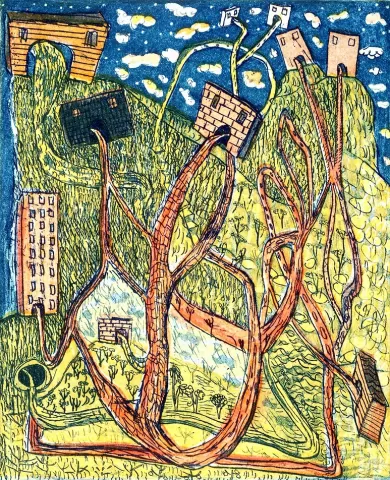Published
Art Alive Gallery, New Delhi, India, 2006
The Open Dream Paths of Tara Sabharwal
Memorable art must always exceed the domain of its means, the range of its terms. Its
experience must open the way for thinking of new ways of encountering the world, but
also new ways of understanding how to encounter the world. This experience is always
subtle and a bit puzzling, and art that remains memorable is indeed art that makes the
puzzling experience of its reception memorable.
Such is my sense of Tara Sabharwal’s art and especially of this new series of etchings
and monotypes that follow her previous accomplishments in drawing and watercolor.
Beyond the evident pleasure of seeing an artist using the material elements of her artwork
to their fullest potential, one cannot help being struck, on the one hand, by a thematics
that favor the landscape of dreams (hence an idiomatic artistic language) and, on the
other hand, by a mode of representation that highlights a corporeal relation to the world.
In these etchings, Tara’s dreams are uniquely incorporated in a range of tangible and
sentient paths, so that even in their most abstract and uniquely configured representations,
beyond the standard depictions of body and mind, person and world, they never beguile
the spectator into the comfort of pure aesthetics.
One might say, paradoxically, that these images pulsate to a certain music: the visual
landscape comes across indeed as a tightly woven harmonic pattern, and yet an amalgam
of singular interventions, of sudden voices crying out, sighs emitted in secret,
exclamations or whispers, questions raised about meaning, expressions of surprise at a
puzzle solved, lullabies of conscience or interrogations of spirit. All these layers of visual
musings, uniquely poised on a specific image or notion in various instances of repetition
– vessels, paths, branches – are consistently interiorized. Tara’s world takes the risk of
disclosing a tangible body – yet, not in the sense of exposing or fetishizing it (violating it
through recognizable depiction), but expressing it in such a way as never to surrender its
enclosure. This is a concrete body that seeks to exhale, and the unveiling of its inner
elements invites us to suspend our own exteriority, to let ourselves become part of its
breath. There is something astonishing in the experience of viewing this work, and this
astonishment, a momentary drawing of one’s breath, registers a sense of being breathed
in, of flowing into the multifarious paths of a visual world that promises no common
denominator.
Culturally speaking, Tara Sabharwal’s work is indecipherable and uncategorizable. This
lends an intransigent, self-confident, ambiguity to her evident concern with the multiple
languages of home (which includes her peregrinations into the landscape of interior
nature: blood, roots, paths of mind and body). One sees here a whole range of images of
homelessness – or perhaps better said, of a concern with the instability of the category
“home”, whether as experience or as prospect. But this work expresses neither nostalgia
nor disaffection. It is dedicated, instead, to the visuality of disclosure. Home is
manifested as an open dialectic of paths: organic, circuitous, enclosed, suspended.
For Tara, the contemplation of homelessness is a way of rendering a productive otherness
– not otherness that presides supreme, unapproachable, or disembodied, like an
exemplary or absolute limit. This work plunges otherness into the body itself, disrupting
a certain comfort and reliance on patterns of recognition, but forging instead an uncanny
intimacy between elements that otherwise make relations uneasy and unyielding. In
Tara’s work, homelessness has a path (or is a path), because even in the most abstract
image the world is right there. This lithe interplay between the artist’s personal language
and a minimally processed presence of historical reality is one of the most striking
elements of Tara’s unique idiom. Even the grave legacy of 9/11 registers visually without
surrendering its concrete experience to aesthetization, but also without yielding any
resistance to being absorbed into an artistic language that existed before the event and
continues to exist, mutable and unencumbered.
Perhaps, that’s why, in surveying this dreamscape of etchings and monotypes, one is left
astonished, yes, but also filled with an enormous sense of intimacy with a world that, no
matter what its enclosures, remains open, playful, unresolved and, yes, optimistic.
